A vertical wire carries a current in upward direction. An electron beam sent horizontally towards the wire will be deflected
towards right
towards left
upwards
downwards
The correct Answer is:C
To solve the problem, we need to analyze the situation step by step:
Step 1: Understand the Setup
We have a vertical wire carrying an upward current, and an electron beam is sent horizontally towards this wire.
Hint: Visualize the setup: the wire is vertical, and the electron beam is horizontal.
Step 2: Determine the Direction of the Magnetic Field
According to the right-hand rule, the direction of the magnetic field (B) around a straight current-carrying wire can be determined by pointing the thumb of your right hand in the direction of the current (upward) and curling your fingers around the wire.
- For a wire with an upward current, the magnetic field will circulate around the wire in a counter-clockwise direction when viewed from above. At the location of the electron beam (to the right of the wire), the magnetic field will be directed into the page (or downward).
Hint: Use the right-hand rule to find the direction of the magnetic field around the wire.
Step 3: Identify the Direction of the Electron Beam
The electron beam is moving horizontally towards the wire. Since electrons are negatively charged, the current associated with the electron beam is in the opposite direction to the electron motion. Therefore, if the electron beam is moving to the left, the current can be considered as moving to the right.
Hint: Remember that the direction of the current is opposite to the direction of electron flow.
Step 4: Apply Fleming's Left-Hand Rule
Fleming's Left-Hand Rule helps us determine the direction of the force experienced by a current-carrying conductor in a magnetic field. According to this rule:
- The thumb represents the direction of the force (F).
- The first finger represents the direction of the magnetic field (B).
- The second finger represents the direction of the current (I).
In this case:
- The magnetic field (B) is directed downward (into the page).
- The current (I) due to the electron beam is moving to the left.
Using Fleming's Left-Hand Rule:
- Point your first finger downwards (B).
- Point your second finger to the left (I).
- Your thumb will point upwards, indicating the direction of the force on the electron beam.
Hint: Use Fleming's Left-Hand Rule to find the direction of the force on the electron beam.
Conclusion
The electron beam will be deflected upwards due to the magnetic force acting on it.
Final Answer: The electron beam will be deflected upwards.
We have a vertical wire carrying an upward current, and an electron beam is sent horizontally towards this wire.
According to the right-hand rule, the direction of the magnetic field (B) around a straight current-carrying wire can be determined by pointing the thumb of your right hand in the direction of the current (upward) and curling your fingers around the wire.
The electron beam is moving horizontally towards the wire. Since electrons are negatively charged, the current associated with the electron beam is in the opposite direction to the electron motion. Therefore, if the electron beam is moving to the left, the current can be considered as moving to the right.
Fleming's Left-Hand Rule helps us determine the direction of the force experienced by a current-carrying conductor in a magnetic field. According to this rule:
- The thumb represents the direction of the force (F).
- The first finger represents the direction of the magnetic field (B).
- The second finger represents the direction of the current (I).
- The magnetic field (B) is directed downward (into the page).
- The current (I) due to the electron beam is moving to the left.
- Point your first finger downwards (B).
- Point your second finger to the left (I).
- Your thumb will point upwards, indicating the direction of the force on the electron beam.
The electron beam will be deflected upwards due to the magnetic force acting on it.
Topper's Solved these Questions
- MAGNETIC FIELD DUE TO CURRENTBOOK - HC VERMA ENGLISHCHAPTER - MAGNETIC FIELD DUE TO CURRENTEXERCISE - Objective 2
7 Videos
- MAGNETIC FIELD DUE TO CURRENTBOOK - HC VERMA ENGLISHCHAPTER - MAGNETIC FIELD DUE TO CURRENTEXERCISE - exercise
60 Videos
- MAGNETIC FIELD DUE TO CURRENTBOOK - HC VERMA ENGLISHCHAPTER - MAGNETIC FIELD DUE TO CURRENTEXERCISE - worked out examples
15 Videos
- MAGNETIC FIELDBOOK - HC VERMA ENGLISHCHAPTER - MAGNETIC FIELDEXERCISE - objective2
9 Videos
- MAGNETIC PROPERTIES OF MATTERBOOK - HC VERMA ENGLISHCHAPTER - MAGNETIC PROPERTIES OF MATTEREXERCISE - Short Answer
6 Videos
Similar Questions
A long vertical wire carrying a current of 10A in the upward direction is placed in a region where a horizontal magnetic field of magnitude(2.0×10−3) T exists from south to north. Find the point where the resultant magnetic field is zero.
View SolutionA matel wire carries a current of one amp. How many electrons pass a point in the wire in one sec.
View SolutionA and B are two conductors carrying a current i in the same direction x and y are two electron beams moving in the same direction. There will be
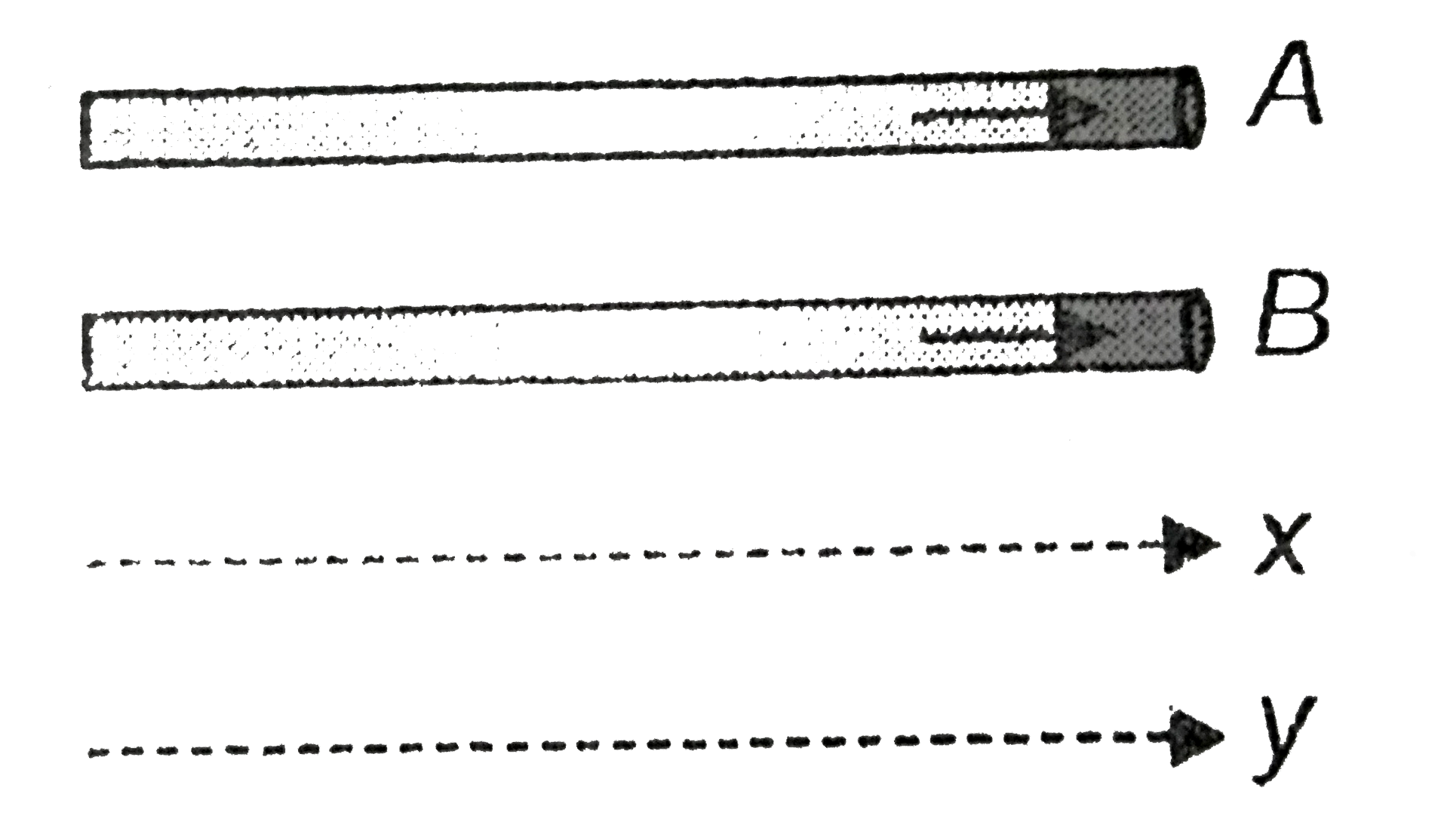
View SolutionA straight wire carries a current of 10A. An electron moving at 103 m/s is at distance 2.0 cm from the wire. Find the force acting on the electron if its velocity is directed toward the wire?
View SolutionTwo parallel wires carrying current in the same direction attract each other while two beams of electrons travelling in the same direction repel each other. Why?
View SolutionTwo parallel wires carrying current in the same direction attract each other while two beams of electrons travelling in the same direction repel each other. Why?
View SolutionA wire is parallel to a square coil . The coil and wire carry currents in the directions Shown . Then, at any point A within the coil the magnetic field will be -
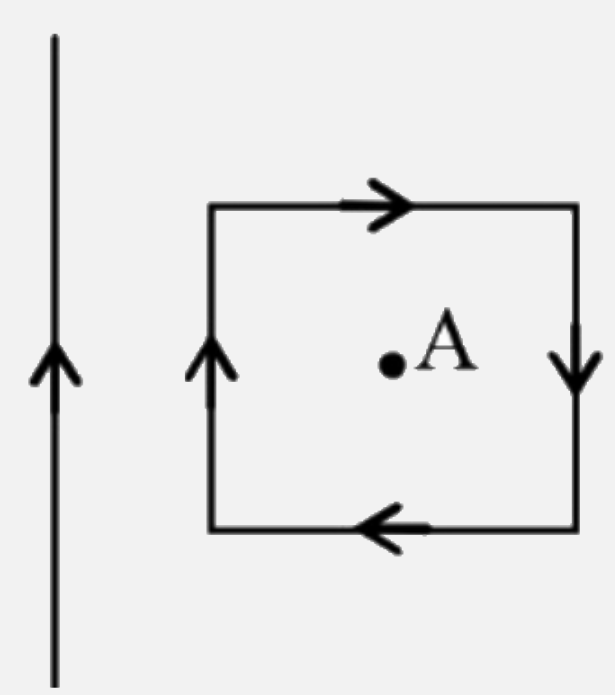
View SolutionAn electron is projectd horizontally with a kinetic energy of 10 keV. A magnetic feld of strength 1.0X10−7 T exists in the vertically upward direction. (a)will the electron deflect towards right or towards left of its motion? (b) calculate the sideways deflection of the electrion in travelling through 1m. make appropriate approximations.
View SolutionTwo infinetely long, parallel wires are lying on the ground at distance a=1cm apart as shown in Fig. A third wire, of length L=10m and mass 400g, carries a current of I1=100A and is levitated above the first two wires, at a horizontal position midway between them. The infinitely long wires carry equal currents I1 in the same directions, but in the direction opposite that in the leviated wire. What current must the infinately long wires carry so that the three wires form an equilateral triangle?
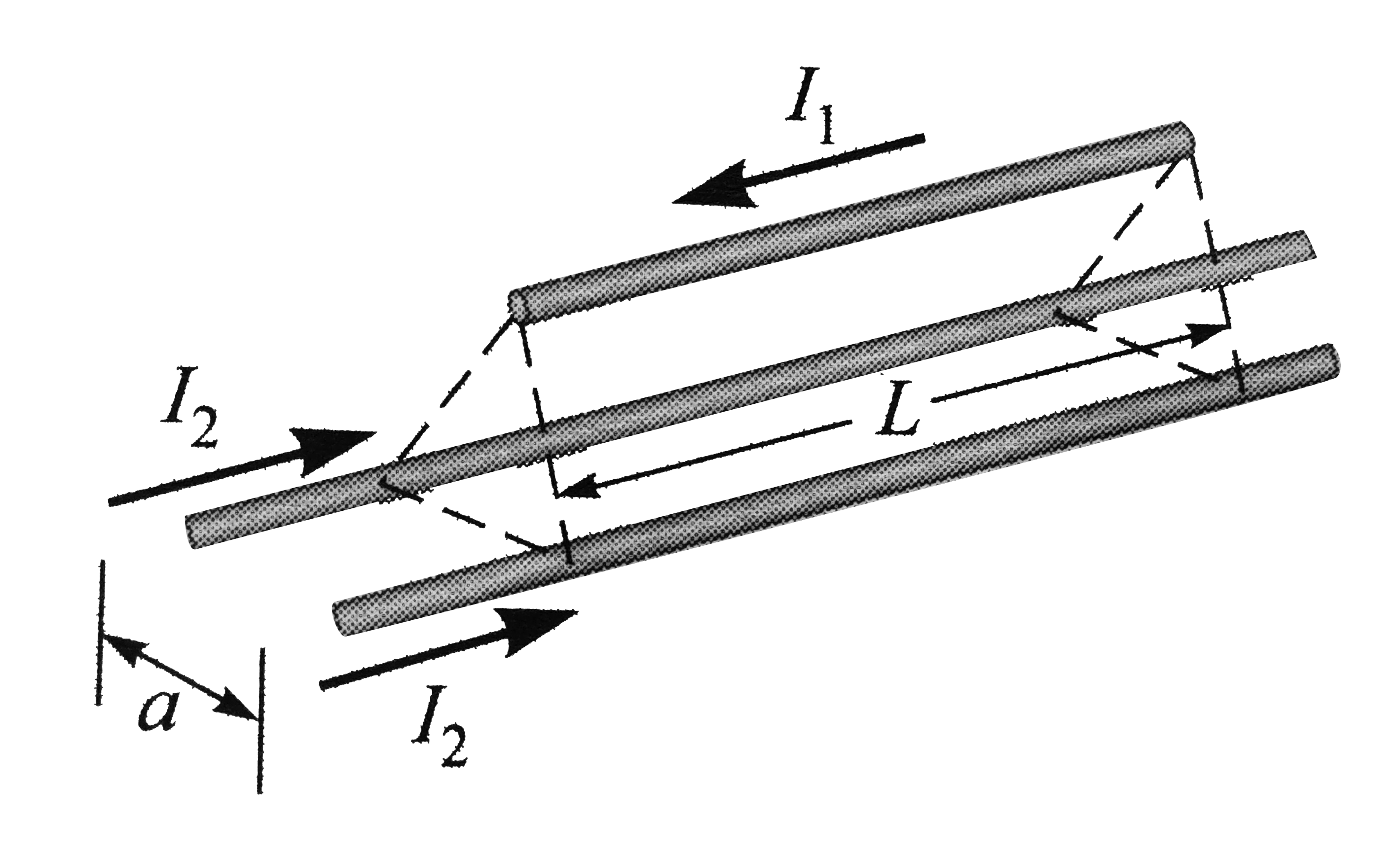
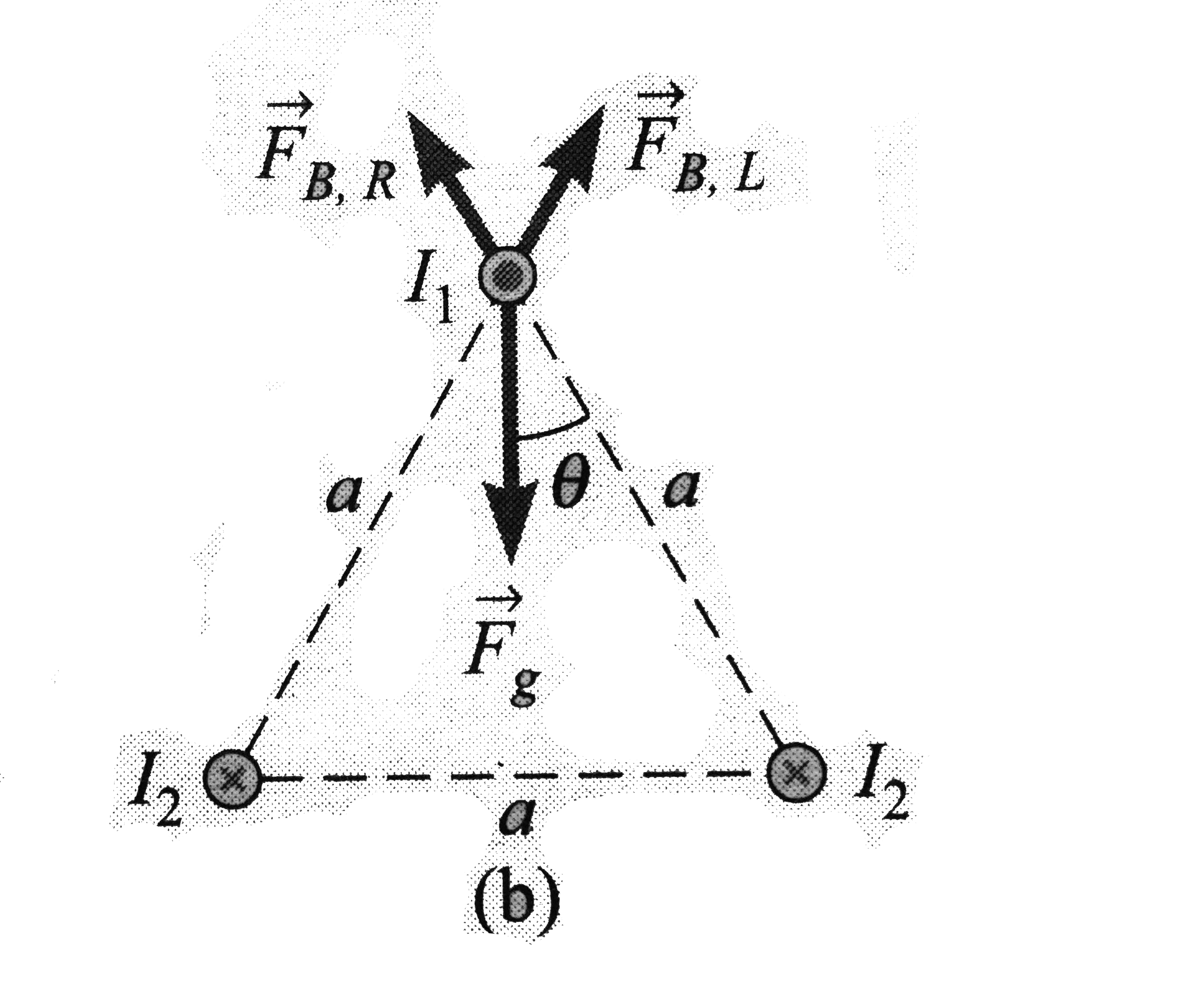
View SolutionA long, horizontal wire AB rests on the surface of a table and carries a current I. Horizontal wire CD is vertically above wire AB, and is free to slide up and down on the two vetical mental guides C and D (as shown in Fig) Wire CD is connected through the sliding contacts to another wire that also carries a current I, opposite in direction to the current in wire AB. The mass per unit length of the wire CD is λ. To what euqilibrium heigth h will the wire CD rise, assuming that magnetic force on it is wholly due to the current in wire AB?
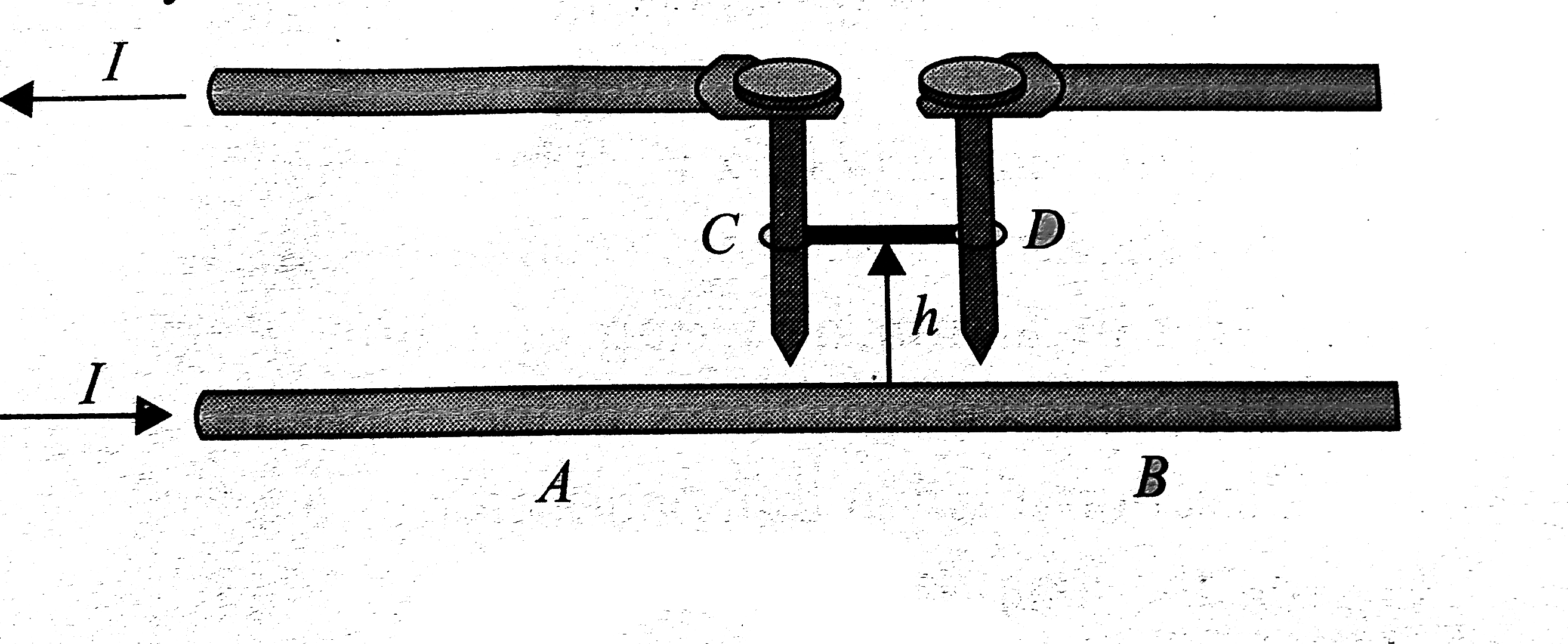
View Solution
